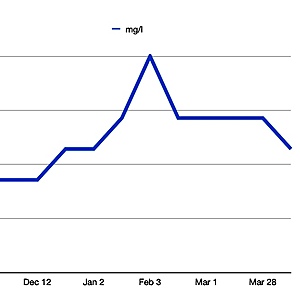
Loon Lake
Ontario, Canada
Open lake approximately 5 meters from shoreline at 3 meters depth. Sand bottom.
Lake flow direction at this point is very low toward NE.

- Group: Water Rangers : Water Rangers Water Quality Testers
- Site ID: LL-002
- Lat: 45.0207625
- Lng: -78.3850112
- Waterbody Type: Lake
- Timezone: America/Toronto
Latest photos
The hot and dry weather has affected the lake water. The TDS has increased with evaporation and the water level in this reservoir lake decreasing. The dissolved oxygen level has increased and has created an increase in the REDOX voltage to 210 mv, which is logical and good for the lake.
Severe heat spell. ORP low below the 300-500 mv range. DO still in a good range.
REDOX was 200 mv.
New dissolved oxygen meter (AZ) in use first time.
ORP (REDOX) was 221 mV. Dissolved oxygen was 6.0 ppm taken 30 m from shore at a deoth of 2 meters. Water sample from well pump source in lake. Water is 5.0 micron filtered and uv treated. REDOX reading slightly below the 300-500 mV recommendation which is logical and in step with a slightly low dissolved oxygen reading. Note theris no CCME guideline for ORP.
The chloride monitoring and reduction work with the MTO has completed for this past winter. The introduction of DLA to the area was successful in reducing the amount of chloride getting into Loon Lake, Dysart et al. The MTO will be expanding the DLA program to include the entire Highway 118 corridor, beginning in the winter of 2025-2026. This project has shown the importance of monitoring water and correcting any discovered issues when discovered. Because low levels, below 20 mg/l were being monitored, a Taylor K1598 kit was used that is basically a drop test kit using titration.
ORP was 247.
This is the first general testing of the season. And the last chloride test for the Ministry of Transportation - Ontario. The MTO was given a graphical summary of the winter season showing the rise in chloride and the rapid decline in chloride with their conversion to Direct Liquid Application in our area.
ORP WAS 247 mV. Lake ice still on. The water sample from a tap fed from a lake pump. Readings at this location are consistent with three other locations on the lake. These readings are all part of an experiment with the Ministry of Transportation - Ontario wherein they apply DLA on the winter roads and I measure the chloride levels in the lake.
Added measurement ORP equals 233 mV. Interestingly the Chloride reading is holding constant at 10 mg/l. There is no input of chloride since early March and with no outflow from the lake yet, therefore is no decline in chloride. Water levels are very slowly increasing but appear to be having no dilution effect.
Tap location. This is part of the chloride monitoring for the MTO project to discover if chloride levels from road salting can be reduced by the introduction of DLA in this area near a lake bordered by a highway. The chloride levels have dropped from 14 to 10 mg/l since the introduction of DLA to prewet NaCl. So far, the experiment/project appears successful.
This is a limited observation meant to measure chloride levels in concert with a chloride reduction project with the Ministry of Transportation. My readings indicate how effective the MTO strategies are in trying new methods of chloride reduction. In this instance the MTO is using a DLA method which is the introduction of a brine solution combined with salt crystals. So far, a drop in chloride levels has been observed with the implementation of DLA.
